Monday, April 23rd 2012

Intel Announces 3rd Generation Core "Ivy Bridge" Processor Family
Intel finally got the ball rolling on its third generation Core processor family codenamed "Ivy Bridge", which will go into making most of the company's client processor portfolio for 2012. These chips are characterized as being the world's first microprocessors built on the 22 nanometer silicon fabrication process. Intel aided miniaturization of circuits to such tiny scale thanks to 3D Transistor technology, a space-efficient nano-scale transistor design that enables chip-designers to achieve higher transistor densities, and come up with ever more powerful chips.
The third-generation Core processor family is based around a single die design (pictured below), from which it will carve out numerous SKUs in the client market in May-June, and enterprise market (under its Xeon brand, towards the end of June). These SKUs will be carved out by toggling the various parallel components (such as x86 cores, cache banks, processor graphics cores, and of course clock-speeds). The new Core processor family is expected to feature higher performance per clock-speed, and higher efficiency. Intel's Kirk Skaugen has been quoted by the BBC as saying "This is the world's first 22 nm product and we'll be delivering about 20% more processor performance using 20% less average power."Fancy new design technology aside, Ivy Bridge features an improved core design from "Sandy Bridge", it packs four x86-64 cores, with an expansive instruction set that includes AVX and AES-NI acceleration, second-generation Turbo Boost technology that tweaks clock speeds of the processor within available Turbo bins quicker, resulting in more energy efficiency, and a new integrated graphics core that is supports DirectX 11. The graphics core also lends a hand at highly parallelized tasks such as video-encoding, using its improved QuickSync Video feature, and can stream display output wirelessly over WiDi.Each of the four cores is aided by 256 KB of dedicated L2 cache, there is 8 MB of shared L3 cache on board, but the amount of this cache enabled varies between models. The chip has a completely integrated northbridge, a dual-channel DDR3 integrated memory controller (IMC), and a PCI-Express gen. 3.0 root complex, which has 16 lanes to spare for graphics (can be arranged as x16, x8/x8, and x8/x4/x4, depending on the motherboard chipset). The processor talks to the motherboard chipset over a 20 Gb/s DMI link. Intel's new 7-series "Panther Point" chipsets are natively supported, and enable some new features, while previous-generation 6-series "Cougar Point" chipsets are also supported, provided the motherboards come with ME8L firmware.
Launched today, are no less than 13 quad-core models under the Core i5 and Core i7 brand extensions. Dual-core parts are reserved for launch "later this spring." Core i7 desktop processors launched today include Core i7-3770K (the crown-jewel of this series), with 3.50 GHz clock speed that cranks itself up to 3.90 GHz on demand, has nearly all components on the Ivy Bridge silicon unlocked, including its base-clock multiplier, which makes overclocking possible. This part is priced around US $330 (prices vary by market). Intel has a more affordable part for overclockers, called the Core i5-3570. This chip features clock speeds of 3.40 GHz with 3.80 GHz max. Turbo speed, and has 6 MB of L3 cache enabled. The Core i5-3570K will be priced around US $230. There are various other models included in today's launch, including the Core i5-3550, i5-3470, and i5-3330. Leading the notebook processor lineup will be Core i7-3615QM, i7-3612QM, and i7-3610QM, etc. Intel's 3rd Generation Core processor family will be gradually available in the retail channel, across all markets.
Says Intel on availability, "Systems based on quad-core 3rd generation Intel Core processor products will be available beginning this month from leading system makers. Boxed versions of these processors will also be available this month from online, retail and channel resellers. Additional versions of the 3rd generation Intel Core processor products for servers, intelligent systems in retail, healthcare and other industries, Ultrabook devices and laptops and more will be available later this year."
Source:
BBC
The third-generation Core processor family is based around a single die design (pictured below), from which it will carve out numerous SKUs in the client market in May-June, and enterprise market (under its Xeon brand, towards the end of June). These SKUs will be carved out by toggling the various parallel components (such as x86 cores, cache banks, processor graphics cores, and of course clock-speeds). The new Core processor family is expected to feature higher performance per clock-speed, and higher efficiency. Intel's Kirk Skaugen has been quoted by the BBC as saying "This is the world's first 22 nm product and we'll be delivering about 20% more processor performance using 20% less average power."Fancy new design technology aside, Ivy Bridge features an improved core design from "Sandy Bridge", it packs four x86-64 cores, with an expansive instruction set that includes AVX and AES-NI acceleration, second-generation Turbo Boost technology that tweaks clock speeds of the processor within available Turbo bins quicker, resulting in more energy efficiency, and a new integrated graphics core that is supports DirectX 11. The graphics core also lends a hand at highly parallelized tasks such as video-encoding, using its improved QuickSync Video feature, and can stream display output wirelessly over WiDi.Each of the four cores is aided by 256 KB of dedicated L2 cache, there is 8 MB of shared L3 cache on board, but the amount of this cache enabled varies between models. The chip has a completely integrated northbridge, a dual-channel DDR3 integrated memory controller (IMC), and a PCI-Express gen. 3.0 root complex, which has 16 lanes to spare for graphics (can be arranged as x16, x8/x8, and x8/x4/x4, depending on the motherboard chipset). The processor talks to the motherboard chipset over a 20 Gb/s DMI link. Intel's new 7-series "Panther Point" chipsets are natively supported, and enable some new features, while previous-generation 6-series "Cougar Point" chipsets are also supported, provided the motherboards come with ME8L firmware.
Launched today, are no less than 13 quad-core models under the Core i5 and Core i7 brand extensions. Dual-core parts are reserved for launch "later this spring." Core i7 desktop processors launched today include Core i7-3770K (the crown-jewel of this series), with 3.50 GHz clock speed that cranks itself up to 3.90 GHz on demand, has nearly all components on the Ivy Bridge silicon unlocked, including its base-clock multiplier, which makes overclocking possible. This part is priced around US $330 (prices vary by market). Intel has a more affordable part for overclockers, called the Core i5-3570. This chip features clock speeds of 3.40 GHz with 3.80 GHz max. Turbo speed, and has 6 MB of L3 cache enabled. The Core i5-3570K will be priced around US $230. There are various other models included in today's launch, including the Core i5-3550, i5-3470, and i5-3330. Leading the notebook processor lineup will be Core i7-3615QM, i7-3612QM, and i7-3610QM, etc. Intel's 3rd Generation Core processor family will be gradually available in the retail channel, across all markets.
Says Intel on availability, "Systems based on quad-core 3rd generation Intel Core processor products will be available beginning this month from leading system makers. Boxed versions of these processors will also be available this month from online, retail and channel resellers. Additional versions of the 3rd generation Intel Core processor products for servers, intelligent systems in retail, healthcare and other industries, Ultrabook devices and laptops and more will be available later this year."
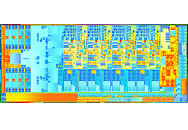
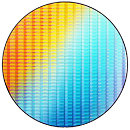
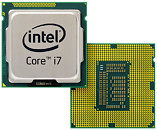
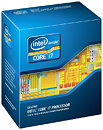
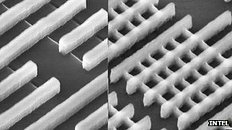
21 Comments on Intel Announces 3rd Generation Core "Ivy Bridge" Processor Family
Though I see I'll have to wait (not too long) for the dual-core i5-3470T. Have a project box that it'll go nicely with.
Now they are taking questions, wonder if anyone will ask about OCing to stable 5Ghz on good air?:D
www.xtremesystems.org/forums/showthread.php?280514-Intel-22nm-Ivy-Bridge-Core-i7-3770K-Reviews
www.intc.com/events.cfm
Its the event listed at the top..
it says click to listen but its a video...
at Stock Vs 4GHz Vs 4.5GHz in a lot of benchmarks :)
After Page 7 there are many many charts:
www.hwbox.gr/reviews/16498-intel-ivy-bridge-core-i5-3570k-review.html
though don't expect to see huge OCs with them, the 3d transistor tech raises the heat output and makes the silicon vary even more between chips.
Problem is, you will only get 4.5Ghz-4.8Ghz on IB with air/ambient cooling vs 5Ghz+ for SB.
If the 3D transistor is the culprit of the heat then that would make sense why IB runs so much hotter than SB. I may just do a SB build if they do some price cutting on it.
Apparently it OC's like crap, max 4.6-4.8ghz (1.35-1.40v max max), heh i was hoping this 3d gate will boost OC not the opposite.www.anandtech.com/show/5771/the-intel-ivy-bridge-core-i7-3770k-review/4
Now im kinda in dilemma with X79 (i7 3820) and later Ivybridge-E 8core, I guess it will have the same ~ 4.6ghz limit.. at least its 16 (IvyBridge pimped) threads :rockout: :D
Especially over 4.6ghz+ (1.35v+)..
www.anandtech.com/show/5763/undervolting-and-overclocking-on-ivy-bridge